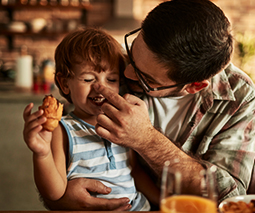Parents warned NOT to rely on baby monitors to keep babies safe

A new research paper has looked at how accurately a couple of leading smartphone integrated baby monitors measure babies’ vital signs, and the news is not at all good.
Some monitors capture inaccurate data
As the baby monitor market gets more and more competitive, unique selling points – like heart rate and oxygen monitors – can help get parents over the line and spending their hard earned cash.
“Smartphone-integrated consumer baby monitors that measure vital signs are popular among parents but are not regulated,” the US study authors point out.
It’s now emerging that the monitoring of these vital signs via some baby monitors and apps is not really as accurate as we’d hope. Parents who are relying on these devices to keep their baby safe may be receiving misleading data about their babies, in fact.
Read more about sleep and safety:
- This powerful new SIDS awareness campaign by Red Nose is a must-watch
- Babies sleep better on their own, finds study. But what about SIDS?
- The co-sleeping message that’s failing parents
Pretty shocking results
The study, administered by Children’s Hospital of Philadelphia (CHOP) Research Institute, tested two smartphone-integrated consumer baby monitors: the Owlet Smart Sock 2 and the Baby Vida,” ABC News reports. “Both use pulse oximetry which monitors the levels of oxygen in the blood as well as the heart rate.”
One of the study’s lead authors, paediatrician Dr Christopher P Bonafide, tested the monitors on 30 babies aged from 0 to six months. Dr Bonafide told Good Morning America that he was “pretty shocked” by the results. He said the monitors seemed very similar in terms of design and technology, but they “performed drastically differently” and were failing to provide correct data.
“Parents are buying these not just to tell them when things are OK, but to tell them when something is wrong. What we’re showing is how these monitors are failing them to some degree.”
Worrying inconsistencies
The study authors said the Owlet Smart Sock 2 worked “fairly well” but had some inconsistencies when compared with a hospital-grade monitor. For instance, the Owlet Smart Sock 2 would sometimes determine that oxygen levels were low when they were perfectly normal. A spokesperson for Owlet countered this saying “the sensor performed well within the industry and regulatory standards for pulse oximetry.”
The Baby Vida monitor accuracy varied pretty dramatically, sometimes saying oxygen levels were low when they were normal, and at other times saying oxygen levels were normal when they were dangerously low. Baby Vida appear to have gone very quiet and have not responded to the study findings.
Real life advice
Dr Bonafide says that it’s important parents discuss the use of this monitor with their child’s doctor.
“Alarms will go off. Those could be false alarms, they could be true alarms. It’s important to have a conversation with the paediatrician to decide what to do when the alarms do go off.”
It’s clear that much work needs to be done when it comes to accuracy and how we use these tools. Parents are advised to rely on safe sleeping guidelines – and their own vigilance – when it comes to keeping their babies sleeping soundly.
Red Nose’s Safe Sleeping Guidelines
Red Nose tells us the following practices create a safer sleep for babies:
- Sleep baby on the back from birth, not on the tummy or side
- Sleep baby with head and face uncovered
- Keep baby smoke free before birth and after
- Provide a safe sleeping environment night and day
- Sleep baby in their own safe sleeping place in the same room as an adult caregiver for the first six to twelve months
- Breastfeed baby









